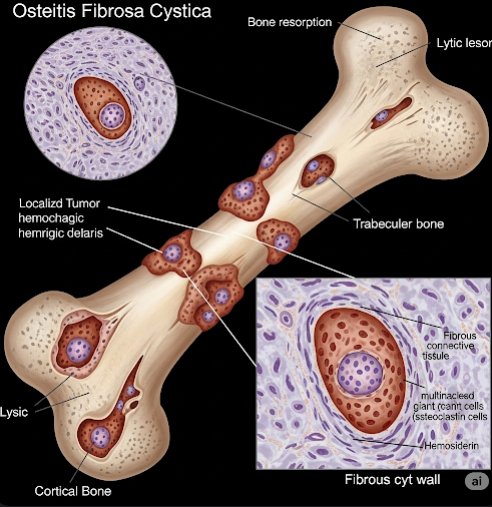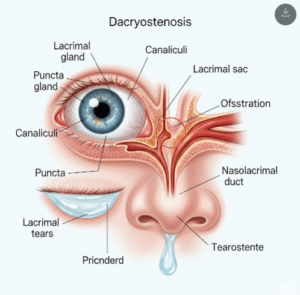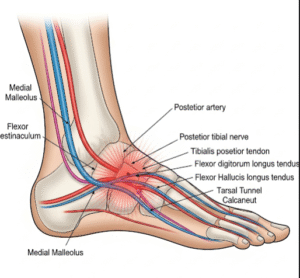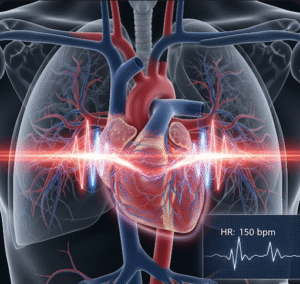Overview
Osteitis Fibrosa Cystica (OFC) is a rare but serious bone disorder caused by overactivity of the parathyroid glands, most commonly due to primary hyperparathyroidism. Excess parathyroid hormone (PTH) causes calcium to be removed from bones, leading to bone weakness, fibrous tissue replacement, and cyst-like lesions. In Korea, advanced endocrinology and orthopedic care are available to diagnose and treat OFC effectively, with a focus on correcting the underlying hormonal imbalance and restoring bone health.
What is Osteitis Fibrosa Cystica?
OFC is a skeletal complication of prolonged hyperparathyroidism, in which high PTH levels trigger excessive bone breakdown (resorption) and replacement of bone tissue with fibrous tissue. Over time, this can cause bone deformities, fractures, and characteristic “brown tumors” (non-cancerous lesions filled with fibrous tissue and blood). The condition is much less common today due to early detection of hyperparathyroidism through routine blood tests, but it can still occur if the underlying cause is untreated.
Symptoms
Symptoms of Osteitis Fibrosa Cystica can vary depending on disease severity, but may include:
- Bone pain and tenderness, often in the arms, legs, pelvis, or spine
- Skeletal deformities in severe cases
- Increased risk of fractures
- Muscle weakness and fatigue
- Swelling or lumps in bones due to “brown tumors”
- Symptoms of high calcium levels (hypercalcemia), such as nausea, constipation, excessive thirst, and frequent urination
Causes
The primary cause of OFC is prolonged high levels of parathyroid hormone, most often due to:
- Primary hyperparathyroidism (caused by parathyroid adenoma, hyperplasia, or rarely, carcinoma)
- Secondary hyperparathyroidism (often due to chronic kidney disease or vitamin D deficiency)
- Tertiary hyperparathyroidism (persistent hyperparathyroidism after kidney transplant)
Risk Factors
Factors that may increase the risk of developing OFC include:
- Untreated hyperparathyroidism
- Chronic kidney disease
- Severe vitamin D deficiency
- Family history of endocrine or parathyroid disorders
- Genetic conditions such as Multiple Endocrine Neoplasia (MEN) syndromes
Complications
If not treated, OFC can lead to:
- Severe bone loss and osteoporosis
- Recurrent bone fractures
- Permanent skeletal deformities
- Kidney stones and kidney damage from high calcium levels
- Impaired mobility and reduced quality of life
Prevention
While OFC itself cannot always be prevented, early detection and treatment of hyperparathyroidism can stop the disease from developing. Preventive measures include:
- Routine blood calcium and PTH level checks in high-risk individuals
- Adequate vitamin D and calcium intake for overall bone health
- Timely treatment of kidney disease and vitamin D deficiency
- Regular bone density scans for those with known endocrine disorders
Treatment Options in Korea
In Korea, the treatment of OFC focuses on managing the underlying parathyroid disorder and restoring bone strength:
- Surgical parathyroidectomy: Removal of overactive parathyroid gland(s), which is often curative for primary hyperparathyroidism
- Medical management: Medications such as calcimimetics, bisphosphonates, or vitamin D supplements for certain patients
- Treatment of secondary causes: Correcting kidney disease-related calcium and phosphorus imbalances
- Orthopedic interventions: Surgery to repair fractures or stabilize bones in severe cases
- Rehabilitation: Physical therapy to improve mobility and strength after treatment
Korea’s specialized endocrine and orthopedic centers use advanced imaging (bone scans, CT, MRI) and laboratory diagnostics to detect OFC early and provide comprehensive treatment plans tailored to each patient’s condition.













